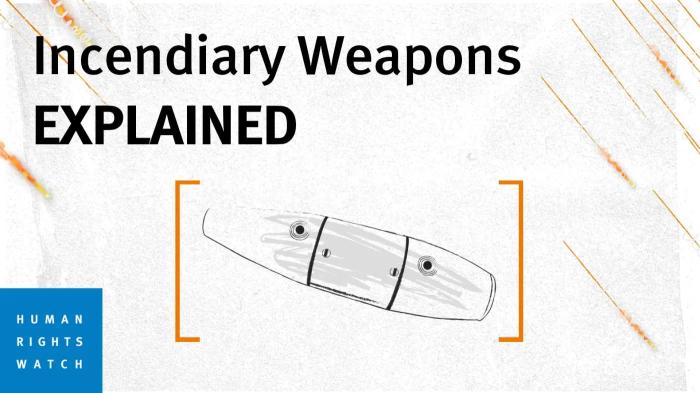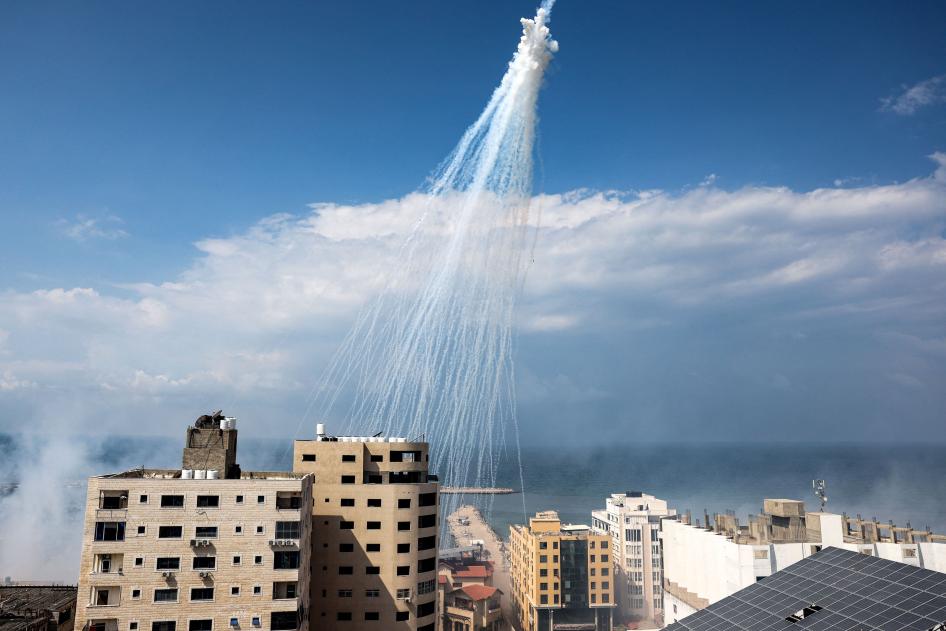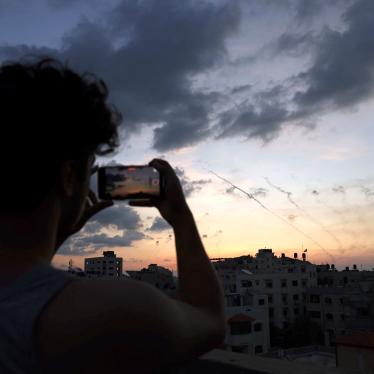Human Rights Watch has determined based on verified video and witness accounts that Israeli forces used white phosphorus in military operations in Lebanon and Gaza on October 10 and 11, 2023, respectively. The videos show multiple airbursts of artillery-fired white phosphorus over the Gaza City port and two rural locations along the Israel-Lebanon border.
White phosphorus, which can be used as a smokescreen or a weapon, has the potential to cause civilian harm due to the severe burns it causes and its lingering long-term effects on survivors. Its use in densely populated areas of Gaza violates the requirement under international humanitarian law that parties to the conflict take all feasible precautions to avoid civilian injury and loss of life. It also highlights the need to reexamine the status and adequacy of Protocol III of the Convention on Conventional Weapons (CCW), currently the only international law dedicated to governing incendiary weapons.
- What is white phosphorus?
- How is white phosphorus used?
- What harm does white phosphorus cause?
- What is the status of white phosphorus under international law?
- What has been Israel’s past policy and practice regarding white phosphorus?
White phosphorus is a chemical substance, dispersed in artillery shells, bombs, and rockets, that ignites when exposed to oxygen. The chemical reaction creates intense 815-degree Celsius heat. It produces light and a thick smoke used for military purposes, but also inflicts horrific injuries when the phosphorus comes in contact with people. It is not considered a chemical weapon because it operates primarily by heat and flame rather than toxicity. White phosphorus can be delivered via felt wedges soaked in phosphorus and emits a distinct “garlic” smell.
White phosphorus is used primarily to obscure military operations on the ground. It can create a smokescreen at night or during the day to mask the visual movement of troops. It also interferes with infrared optics and weapon tracking systems, thus protecting military forces from guided weapons such as anti-tank missiles.
When airburst, white phosphorus covers a larger area than when groundburst and is useful to mask large troop movements. In so doing, however, it spreads the incendiary effects over a wider area, and in densely populated areas like Gaza it increases the risks to civilians. When the weapon is groundburst, the danger zone is more concentrated, and the smokescreen remains for longer. The cloud from white phosphorus is dependent on atmospheric conditions, so it is not possible to generalize how long it will remain in the air.
White phosphorus can also be used as an incendiary weapon. US forces used white phosphorus during the second battle of Fallujah in Iraq in 2004 to “smoke out” concealed combatants, who were then attacked.
White phosphorus causes severe burns, often down to the bone, that are slow to heal and likely to develop infections. If not all fragments of white phosphorus are removed, they can exacerbate wounds after treatment and reignite when exposed to oxygen. White phosphorus burns on only 10 percent of a human body are often fatal. It can also cause respiratory damage and organ failure.
Those who survive their initial injuries often experience a lifetime of suffering. Contractures—the permanent tightening of muscles and other tissue—impede mobility, while the trauma of the initial attack, painful treatments, and appearance-changing scars lead to psychological harm and social exclusion.
The fires caused by white phosphorus can also destroy civilian structures and property, damage crops, and kill livestock. Furthermore, inadequate resources available to medical providers in armed conflict settings exacerbate the already challenging process of treating serious burns.
When used as a weapon, munitions with white phosphorus are considered incendiary weapons. Although incendiary weapons are not explicitly banned by international humanitarian law, customary international humanitarian law requires states to take all feasible precautions to avoid the harm to civilians caused by those weapons.
In addition, incendiary weapons are governed by Protocol III to the CCW. Palestine and Lebanon have joined Protocol III, while Israel has not ratified the protocol. Protocol III prohibits the use of airdropped incendiary weapons in “concentrations of civilians,” but it has two significant loopholes.
First, it restricts some but not all use of ground-launched incendiary weapons where there are concentrations of civilians, which would encompass white phosphorus artillery strikes in Gaza. Second, the protocol’s definition of incendiary weapons covers weapons that are “primarily designed” to set fires and burn people and thus arguably excludes multipurpose munitions, such as those containing white phosphorus if they are being used as smokescreens, even if they cause the same incendiary effects. Human Rights Watch and many CCW states parties have recommended closing that loophole and strengthening the restriction on the use of ground-launched incendiary weapons.
Human Rights Watch endorses the widely supported call for CCW states parties to agree at their November 2023 meeting to set aside time for dedicated discussions of the status and adequacy of Protocol III.
From December 27, 2008, to January 18, 2009, during Operation Cast Lead, the Israeli military fired approximately 200 ground-launched white phosphorus munitions into populated areas of Gaza. Israeli forces relied particularly on 155mm M825E1 artillery projectiles, which send burning phosphorus wedges 125 meters in all directions, giving them a broad area effect. Israel’s Ministry of Foreign Affairs stated that the Israeli military used the shells only to create smokescreens. Whatever their ostensible purpose, however, Human Rights Watch found dozens of civilian casualties in the six incidents it documented. The white phosphorus shells also damaged civilian structures, including a school, a market, a humanitarian aid warehouse, and a hospital.
The attacks generated international and domestic outrage. In 2013, in response to a petition before Israel’s High Court of Justice regarding the Gaza attacks, the Israeli military claimed that it would no longer use white phosphorus in populated areas except in two narrow situations that it revealed only to the justices. In the court’s ruling, Justice Edna Arbel explained that the conditions would “render use of white phosphorous an extreme exception in highly particular circumstances.” Although this pledge to the court did not represent an official change in policy, Justice Arbel called on the Israeli military to conduct a “thorough and comprehensive examination” and adopt a permanent military directive.
Also in 2013, the Israeli armed forces announced it was developing new smoke shells without white phosphorus. It stated it reserved the right to use and stockpile its white phosphorus munitions until it had sufficient alternatives, but explained that “[d]epending on the outcome of this development process, the new shells are intended to gradually replace the current smoke shells as the primary means employed by the IDF [Israel Defense Forces] for screening purposes.”









